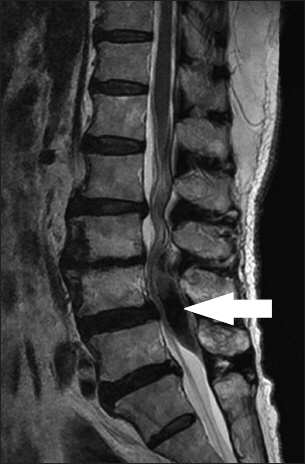Anesth Pain Med.
2019 Jan;14(1):102-105. 10.17085/apm.2019.14.1.102.
Epidural hematoma after total knee arthroplasty in a patient receiving rivaroxaban: A case report
- Affiliations
-
- 1Department of Anesthesiology and Pain Medicine, Nowon Eulji Medical Center, Eulji University College of Medicine, Seoul, Korea. potterydoll@gmail.com
- KMID: 2434207
- DOI: http://doi.org/10.17085/apm.2019.14.1.102
Abstract
- Rivaroxaban, a factor Xa inhibitor, is one of the newly developed direct oral anticoagulants (DOAC). In recent times, it has been increasingly used in the prevention of pulmonary embolism in patients undergoing orthopedic surgery. This report describes a case of epidural hematoma in an elderly patient who underwent combined spinal epidural anesthesia for total knee arthroplasty; the patient received rivaroxaban postoperatively for 7 days to prevent pulmonary embolism. Additionally, the epidural hematomas developed on the 5th postoperative day but the patient recovered well with conservative treatment. Although rivaroxaban has a low need for monitoring and is easily administered, the guidelines should be carefully checked for the postoperative administration schedule in patients undergoing regional anesthesia. In addition, rivaroxaban should be used with caution, especially in elderly patients.
MeSH Terms
Figure
Reference
-
1. Mekaj YH, Mekaj AY, Duci SB, Miftari EI. New oral anticoagulants: their advantages and disadvantages compared with vitamin K antagonists in the prevention and treatment of patients with thromboembolic events. Ther Clin Risk Manag. 2015; 11:967–77. DOI: 10.2147/TCRM.S84210. PMCID: PMC4485791. PMID: 26150723.2. Douxfils J, Ageno W, Samama CM, Lessire S, Ten Cate H, Verhamme P, et al. Laboratory testing in patients treated with direct oral anticoagulants: a practical guide for clinicians. J Thromb Haemost. 2018; 16:209–19. DOI: 10.1111/jth.13912. PMID: 29193737.3. Mao YC, Chen ST, Chen CH, Hsieh KP, Gan KH. Rivaroxaban in preventing venous thromboembolism after arthroplastic surgery in Taiwan. Kaohsiung J Med Sci. 2015; 31:534–9. DOI: 10.1016/j.kjms.2015.08.003. PMID: 26520693.4. Ruff CT, Giugliano RP, Braunwald E, Hoffman EB, Deenadayalu N, Ezekowitz MD, et al. Comparison of the efficacy and safety of new oral anticoagulants with warfarin in patients with atrial fibrillation: a meta-analysis of randomised trials. Lancet. 2014; 383:955–62. DOI: 10.1016/S0140-6736(13)62343-0. PMID: 24315724.5. Uchiyama S, Ibayashi S, Matsumoto M, Nagao T, Nagata K, Nakagawara J, et al. Dabigatran and factor Xa inhibitors for stroke prevention in patients with nonvalvular atrial fibrillation. J Stroke Cerebrovasc Dis. 2012; 21:165–73. DOI: 10.1016/j.jstrokecerebrovasdis.2012.01.011.6. Spyropoulos AC, Douketis JD. How I treat anticoagulated patients undergoing an elective procedure or surgery. Blood. 2012; 120:2954–62. DOI: 10.1182/blood-2012-06-415943. PMID: 22932800.7. Robert-Ebadi H, Le Gal G, Righini M. Use of anticoagulants in elderly patients: practical recommendations. Clin Interv Aging. 2009; 4:165–77. PMID: 19503778. PMCID: PMC2685237.8. Conway SE, Hwang AY, Ponte CD, Gums JG. Laboratory and clinical monitoring of direct acting oral anticoagulants: what clinicians need to know. Pharmacotherapy. 2017; 37:236–48. DOI: 10.1002/phar.1884. PMID: 27983747.9. Albaladejo P, Samama CM, Sié P, Kauffmann S, Mémier V, Suchon P, et al. Management of severe bleeding in patients treated with direct oral anticoagulants: an observational registry analysis. Anesthesiology. 2017; 127:111–20. DOI: 10.1097/ALN.0000000000001631. PMID: 28410272.10. Cuker A, Siegal DM, Crowther MA, Garcia DA. Laboratory measurement of the anticoagulant activity of the non-vitamin K oral anticoagulants. J Am Coll Cardiol. 2014; 64:1128–39. DOI: 10.1016/j.jacc.2014.05.065. PMID: 28410272. PMCID: PMC4167772.11. Siegal DM, Garcia DA, Crowther MA. How I treat target-specific oral anticoagulant-associated bleeding. Blood. 2014; 123:1152–8. DOI: 10.1182/blood-2013-09-529784. PMID: 24385535.12. Burjorjee JE, Rooney R, Jaeger M. Epidural hematoma following cessation of a direct oral anticoagulant: a case report. Reg Anesth Pain Med. 2018; 43:313–6. DOI: 10.1097/AAP.0000000000000738. PMID: 29369958.
- Full Text Links
- Actions
-
Cited
- CITED
-
- Close
- Share
- Similar articles
-
- Spinal epidural hematoma after epidural anesthesia in a patient receiving enoxaparin: A case report
- Epidural Abscess Following Epidural Catheterization for Painless Mobilization after Total Knee Arthroplasty
- Comparison of Hematologic Changes between Rivaroxaban and Aspirin for Venous Thromboembolism Prophylaxis after Total Knee Arthroplasty
- Femoral Nerve Palsy due to Noninfectious Iliopsoas Bursitis and Hematoma after Total Hip Arthroplasty: A Case Report
- Popliteal Artery Pseudoaneurysm Following Primary Total Knee Arthroplasty


